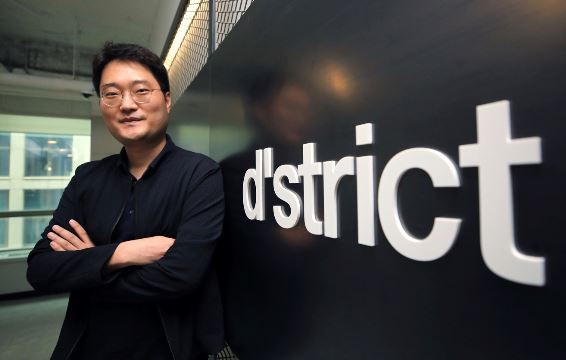A massive wave crashing into the sides of what looks like a giant glass tank, but is actually a wrap-around LED display, grabbed the attention of not just passers-by but international media in May.
D’strict, the company that created the public media art titled “WAVE” at Coex K-pop Square in Seoul, used a technology called anamorphic illusion to realistically express the force of nature with superb three-dimensional effects.
In August, D’strict unveiled “Starry Beach,” a media art installation showing a six-meter-high projection of crashing waves on the walls and floors of an exhibit hall.
While spectators marveled at the breathtaking artistic and technological expression of the waves, the company’s CEO Lee Sung-ho said he believes “WAVE” and “Starry Beach” were loved because of the creators’ strict commitment to quality, rather than the technology.
“Like our brand philosophy ‘d’strict = design + strict,’ our corporate culture is about our obsession with the quality of our creative work,” Lee told Herald Corp.
“We don’t stop when the client is satisfied; we continue to revise and supplement until we are satisfied ourselves.”
Citing the etymology of the word “art,” he also said he sees art and technology as two domains that come from the same roots.
“We think technology can be an excellent tool in expanding the mode of expression in art. For instance, the invention of photography led to the fade-out of modern art that focused on visual reproduction, and gave way to contemporary art which needs the artists’ ideas,” Lee said.
“I think media technology is a new tool that, like the invention of photography, allows different artistic expressions.”
Digital media trends have evolved with transformations in media technology.
The three elements of digital media -- the input device or interface through which data is entered; the hardware or software that processes the data; and the display that expresses that data – have gone through major technological developments.
“The 1990s marked the dawn of the concept ‘digital media.’ A new media platform called the web had emerged, but it was a bit awkward to talk about digital media. It was simply a time when personal computers were developed, and the display went from black-and-white to color,” Lee said.
“The use of the web as a media platform increased explosively in the 2000s, during which various contents and services emerged on a standardized media platform called the web. Only one-way communication was possible in the beginning, but services that allow two-way communication gradually emerged.”
With the popularization of smartphones and other mobile devices in the 2010s, digital media grew exponentially in both quality and quantity.
“We can no longer imagine our lives without smartphones, and this is because digital media is connecting people to other people and data,” Lee said.
“Since the mid-2010s, digital media began to combine with immersive media technology such as virtual reality (VR), augmented reality (AR) and mixed reality (MR), and is going through major advancements. I think we will be able to achieve perfect virtual experiences that can replace humans’ real experience without the use of uncomfortable devices such as HMD within the next 10 years.”
According to Lee, design related to digital media from now is likely to focus a lot on advancing virtual experiences to a level that can perfectly replace human senses.
“If digital media technology can create perfect virtual experiences that can replace real experiences, it could create huge added values in various industries. For example, if you can see and feel a Maldives beach through immersive media technology, you might not have to buy plane tickets or spend time to actually go to Maldives,” he said.
In September, D’strict opened a media art gallery in Aewol, Jeju Island.
The company plans to unveil new works at the Garden space of Arte Museum in Jeju from July next year.
Lee’s team is thinking of creating a media art show that combines traditional Korean landscape paintings and ink-and-wash paintings with Korean music.
They are also musing over collaborating with photographers who deliver amazing visuals to create a media art show for a “beautiful and supernatural” expression of the Earth.
By Kim So-hyun(
sophie@heraldcorp.com)








![[Today’s K-pop] Blackpink’s Jennie, Lisa invited to Coachella as solo acts](http://res.heraldm.com/phpwas/restmb_idxmake.php?idx=644&simg=/content/image/2024/11/21/20241121050099_0.jpg)